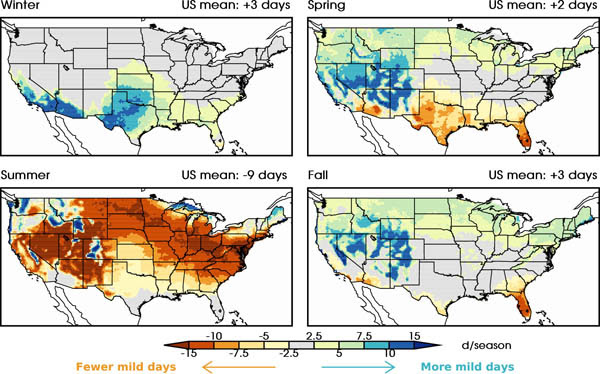The new reports are out: everything, from Thailand to Saskatchewan, is heating up. By the end of the century, people may be planning destination weddings in Canada, now poised to become a balmy getaway.
Last year was the hottest year on record—marking the third successive year that record has been broken, according to the National Oceanic and Atmospheric Administration (NOAA) global temperature report. This means unprecedented global warming, and the both extreme and subtle weather changes within the next century.
Videos by VICE
Meanwhile, in the first ever study on how climate change will affect mild weather—the kind many of us experience the most—scientists from NOAA and Princeton University predict that patterns of mild weather are likely to shift away from the equator toward the poles. Our cities and daily activities are built around these days of mild weather, the days that are neither too hot nor cold to be outside, and losing them could have negative impacts on our economies and health.
The global prognosis is dim at best, with the number of mild weather days starting to fall even within the next couple decades. Mid-latitude regions like Canada might actually see an increase of mild weather days, whereas tropical areas like Southeast Asia could see a precipitous decrease in mild weather days as their hot days get hotter. These reports are the first to confirm that it’s not just extreme weather and storms that are changing, but our everyday climate.
“Extreme weather is difficult to relate to because it may happen only once in your lifetime,” said lead author and physical scientist Karin van der Wiel, of Princeton University, in a public statement. “We took a different approach here and studied a positive meteorological concept, weather that occurs regularly, and that’s easier to relate to.”
Using high resolution climate models, decades of Earth systems data, and the pixelated help of Gaia and Theia—two of NOAA’s high performance supercomputers—the team of scientists were able to build a data-based picture of how nice days are going to look on Earth in the coming decades.
Based upon their analysis the scientists predicted that golden weather days, between 64 and 86 degrees Fahrenheit, will decrease in frequency 10 to 13 percent by 2100. But geography will determine even more of what the next generation will experience.
“Predicting changes in mild weather is not only important to business and industry, but can also contribute to research on the future of physical and mental health, leisure and urban planning,” said Sarah Kapnik, physical scientist at NOAA and co-author of the paper.
Where you live will determine the kind of climate changes you experience. The tropical regions of the world in Africa, Asia, and Latin America could see precipitous drops in the number of mild weather days, and increased heat and humidity. These areas—many already suffering under climate change—could lose between 15 to 50 days of mild weather a year. This will be particularly painful in regions like Sub-Saharan Africa where climate-related drought and starvation have already hammered the continent.
Temperatures in the Arctic this fall were 20 to 30 degrees Fahrenheit above the normal. In May, people in the town of Phalodi, India persevered through the hottest day in the country’s history—a sweltering 123.8 degrees.
Meanwhile, mid-latitude regions like the much of the United States, Europe and Canada, as well as mountainous areas scattered about the world, stand to gain more days of mild weather, a boon only in the short-term view. In the US, this gives the northern states bordering Canada the best weather, and the southern states a lot of sweaty heat. Canada, England and parts of Northern Europe could see an added 10 to 15 days of pleasant weather a year by 2100.

Image: Van der Wiel/NOAA/Princeton
But everything comes at a price: all across the globe summer will become the season to dread. Heat and humidity will likely claim its mild days. Any added days of nice weather will go to autumn, winter and spring. This means more drought, and more energy consumption as we scramble to stay cool.
This year may not be as hot as last year since 2016 included El Niño, the climatic influencing event caused by a hotspot in the Pacific Ocean. But the overall upward trend is an important take away.
Gavin Schmidt, director of NASA’s Goddard Institute for Space Studies, said in a joint teleconference with Arndt from NOAA, that although 2017 will probably be lower in average temperature than 2016, it will “still be a top five year. I’m confident about that.”
Unfortunately, the US leadership will not be doing anything on human-caused climate change. President-elect Donald Trump believes climate change is a hoax and is currently trying to fill his cabinet with many other climate change skeptics. Even now, coastal communities in the U.S. are spending billions of dollars fighting tidal flooding, while Congress looks the other way.
Read More: Goodbye World: We’ve Passed the Carbon Tipping Point for Good
When asked by a reporter during a teleconference if he thought the incoming Trump Administration, chief of global climate monitoring for NOAA was blunt: “We prepared this for the American people.”
Read more of Motherboard’s climate change coverage:
- Not Even Bacteria Are Safe from Climate Change
- The Climate Change Deniers in Congress
- The Bizarre Chain of Events That Led to an Unusual Number of Ticks This Summer
- The Number of US Households That Can’t Afford Water Could Triple in Five Years
- Goodbye World: We’ve Passed the Carbon Tipping Point For Good
Get six of our favorite Motherboard stories every day by signing up for our newsletter.
More
From VICE
-

Beachcombers of Newfoundland and Labrador / Facebook -

April 1972: The tracks of a moon rover on the lunar surface during the Apollo 16 mission. (Photo by MPI/Getty Images) -

Indoor Vertical Farming courtesy Plenty -

Tailed-Jay Butterfly Photo by Gerard Lacz/Shutterstock
